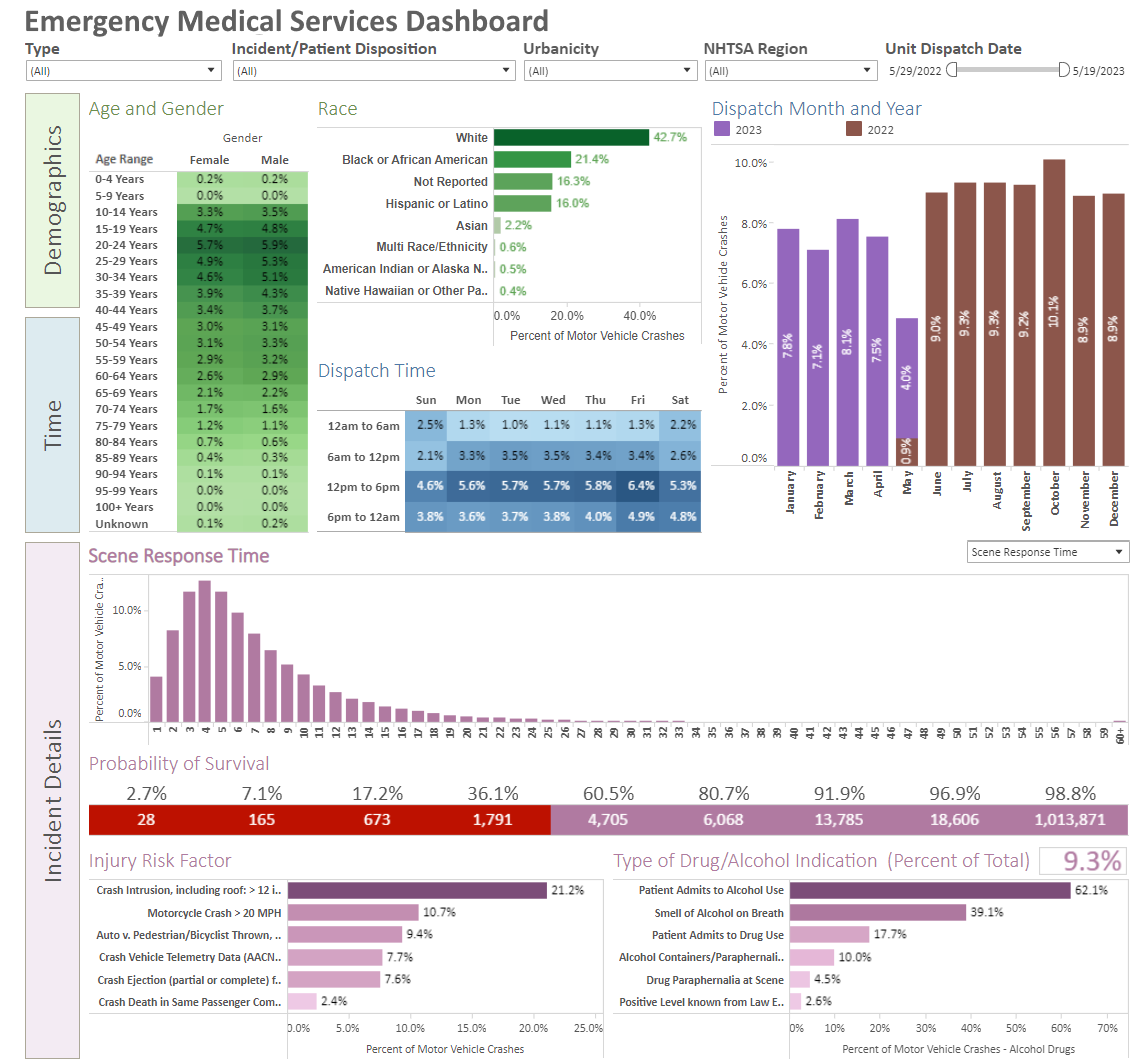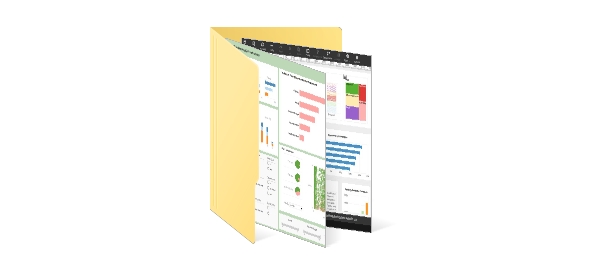What KPIs and Analytics Are Used on Emergency Medical Services Dashboards?
Emergency Medical Services (EMS) are essential in saving lives in life-threatening circumstances. The efficacy and efficiency of these services are guaranteed by EMS organizations via data-driven decision-making.
Dashboards for emergency medical services provide as a single location for tracking, assessing, and enhancing operations. This article discusses EMS dashboard KPIs and analytics to improve emergency response, patient care, and system performance.
Response Time Metrics
- Some of the most important KPIs for emergency medical services are response time measures. These measurements provide light on how soon emergency medical services may arrive at a location. A few important reaction time measurements are:
- Response Time (RT): The response time (RT) is the amount of time that passes between receiving a call and an EMS unit arriving on the site. In cases when life is at risk, a quicker reaction time (RT) is indicative of a more prompt and efficient response.
- Scene Time (ST): ST is the amount of time emergency medical workers spend on the site. It covers patient loading, therapy, and evaluation. Monitoring ST promotes effective patient care and resource allocation.
- Transport Time (TT): The time it takes to get a patient from the scene to the hospital is measured by TT. Better patient results may result from shorter TTs, particularly in situations when time is of the essence.
Call Volume and Distribution
Capacity planning and resource allocation need an understanding of call volume and distribution. The EMS dashboard records:
- Call Volume: the total number of emergency calls that were made within a certain time frame. A jump in call traffic might be a sign of increased demand, necessitating equipment and personnel changes.
- Call Distribution: The distribution of calls by time of day and geography may be analyzed to determine peak call hours and high-demand locations. Decisions on shift scheduling and station placement are based on this data.
Fleet Management
Effective EMS vehicle management is essential to guarantee prompt responses and save operating expenses. KPIs and statistics pertaining to fleet management are included in EMS dashboards:
- Vehicle Utilization: It is possible to discover assets that are over or underused and improve resource allocation by keeping track of how often each vehicle is used.
- Maintenance Needs: Keeping an eye on vehicle repair histories and maintenance programs guarantees that EMS units are operating at peak efficiency and reduces downtime.
- Fuel Efficiency: Reducing operational expenses and environmental effect is facilitated by fuel usage analysis and route planning.
Patient Outcomes
The ultimate goal of EMS organizations is to enhance patient outcomes. KPIs and data on patient care and survival rates are included in dashboards:
- Patient Disposition: Monitoring the locations of transferred patients, such trauma centers or specialty hospitals, aids in evaluating how well referral procedures work.
- Survival Rates: EMS services are able to assess the level of treatment given and pinpoint areas that need improvement by keeping an eye on the survival rates for certain medical diseases or forms of trauma.
Crew Performance
An essential part of providing high-quality treatment is played by EMS workers. EMS dashboards use a range of KPIs to evaluate staff performance.
- Patient Contact Time: The amount of time that passes from the moment an EMS team arrives on the site and when the patient is taken care of and transported is measured.
- Protocol Adherence: Monitoring clinical protocol adherence guarantees that emergency medical services (EMS) staff adhere to recommendations based on evidence, resulting in consistent and superior treatment.
Equipment and Medication Management
A well-stocked pharmacy and well-maintained equipment are essential for providing patients with quality treatment. Metrics on drug administration and equipment are included in EMS dashboards:
- Equipment Availability: Patient treatment is not delayed when all required medical equipment is present and operating.
- Medication Inventory: Stockouts and waste may be avoided by keeping an eye on prescription amounts and expiry dates.
Compliance and Reporting
EMS organizations have to follow reporting and regulatory standards. Dashboards are useful for monitoring adherence to certain standards:
- Documentation Accuracy: It is essential to guarantee the accuracy and completeness of patient care records for both legal and regulatory considerations.
- Regulatory Reporting: EMS dashboards assist agencies fulfill their reporting requirements by making it easier to gather and submit the data that is needed by regulatory authorities.
Geographic Information System (GIS) Integration
To improve decision-making, a lot of EMS dashboards use geographic information systems. GIS analytics may provide insightful information on call grouping, response times, and route optimization:
- Heat Maps: By using heat maps to visualize call density, it becomes possible to better allocate resources by identifying places that get a high number of emergency calls.
- Route Optimization: When EMS units are sent, GIS analytics may recommend the best routes based on past data, traffic patterns, and road conditions.
Quality Assurance and Continuous Improvement
Continual development is a cornerstone of EMS. Dashboards assist with efforts related to quality assurance:
- Performance Benchmarking: It is possible to identify opportunities for improvement in EMS agencies by comparing key indicators with industry standards and benchmarks.
- Root Cause Analysis: Agencies may find the core causes of problems and put remedial measures in place by analyzing occurrences, response times, and patient outcomes.
Public Health Monitoring
When it comes to public health crises like disease outbreaks and natural catastrophes, EMS services are often on the front lines. EMS dashboards might provide the following KPIs for tracking public health:
- Syndromic Surveillance: Monitoring trends in patient complaints and symptoms might be useful in spotting possible disease outbreaks or clusters.
- Resource Allocation: EMS dashboards help direct resources, such as vaccinations and personal protective equipment, to high-risk locations during public health emergencies.
Crew Availability and Scheduling
- Crew Availability: Ensuring that there is an adequate number of workers available to rapidly react to crises is ensured via real-time monitoring of crew availability.
- Overtime Hours: Monitoring extra hours contributes to labor cost management and keeps EMS workers from burning out.
- Shift Compliance: For constant staffing levels, crew adherence to planned shifts and rotations must be analyzed.
Equipment Readiness and Maintenance
- Equipment Readiness Rate: This KPI calculates the proportion of EMS vehicles that are always fully loaded and prepared for use.
- Preventive Maintenance Compliance: Preventive maintenance on vehicles and equipment should be scheduled to reduce unplanned repairs.
- Equipment Failure Analysis: Analytics may help EMS services make well-informed choices regarding equipment replacement or maintenance by identifying recurrent equipment problems.
Pediatric Response Metrics
Pediatric patients with special requirements are often handled by EMS organizations. Dashboards might include KPIs for pediatric care, such as:
- Pediatric Transport Rate: The pace at which pediatric patients are transferred to the proper pediatric institutions is a useful indicator of how well the treatment is working.
- Pediatric Specialty Care Access: Examining the service area's specialist pediatric care facilities' accessibility guarantees quick access when required.
Telemedicine Integration
As telemedicine has developed, certain emergency medical services have included telehealth features. Relevant KPIs consist of:
- Telemedicine Utilization: The amount of telehealth consultations performed by emergency medical services staff may be tracked to get information into the uptake and efficacy of telemedicine services.
- Telehealth Response Times: Tracking how long it takes for telemedicine sessions to start may assist guarantee that patients get treatment on time.
Patient Feedback and Satisfaction
Input from patients is important for enhancing EMS offerings. Patient satisfaction-related KPIs may be seen on dashboards:
- Patient Survey Responses: Finding opportunities for patient experience enhancement is made easier by analyzing survey answers from patients.
- Net Promoter Score (NPS): NPS gauges a patient's loyalty and propensity to refer others to EMS services.
Hazardous Materials (HazMat) Response
Dashboards for EMS organizations participating in HazMat response might provide KPIs for HazMat incidents:
- HazMat Incident Frequency: Monitoring the quantity of HazMat occurrences facilitates the assessment of readiness and training efficiency.
- Response Time to HazMat Incidents: To reduce exposure and maintain containment, it is essential to track the amount of time it takes to reach HazMat situations.
Mental Health Call Metrics
An abundance of calls involving mental health issues are handled by EMS organizations. Dashboard KPIs pertaining to these situations might be present:
- Mental Health Call Volume: Allocating suitable resources and training is facilitated by analyzing the frequency of calls relating to mental health.
- De-escalation Success Rate: Development of protocols and training are influenced by tracking the effectiveness of de-escalation tactics used by EMS workers in mental health emergencies.
Data Security and Privacy Compliance
In the healthcare industry, patient privacy and data security are crucial. Dashboards might provide KPIs for following data protection laws, such as:
- Data Breach Incidents: Ensuring adherence to data security standards is facilitated by keeping an eye on the quantity and severity of data breaches.
- Privacy Audits: Monitoring the results of privacy audits guarantees that patient data is managed legally and safely.
Community Outreach and Education
EMS companies often take part in outreach and education programs in the community. Dashboards might provide KPIs for certain kinds of activities:
- Outreach Events Conducted: Measuring the quantity of educational sessions and community activities conducted facilitates the evaluation of community participation.
- Educational Material Downloads: Assessing how well the general population uses educational resources may provide information about the success of outreach initiatives.
Cost per Call
A thorough analysis of emergency call costs is necessary for budgetary planning and financial planning. This KPI aids in identifying potential opportunities for cost savings.





